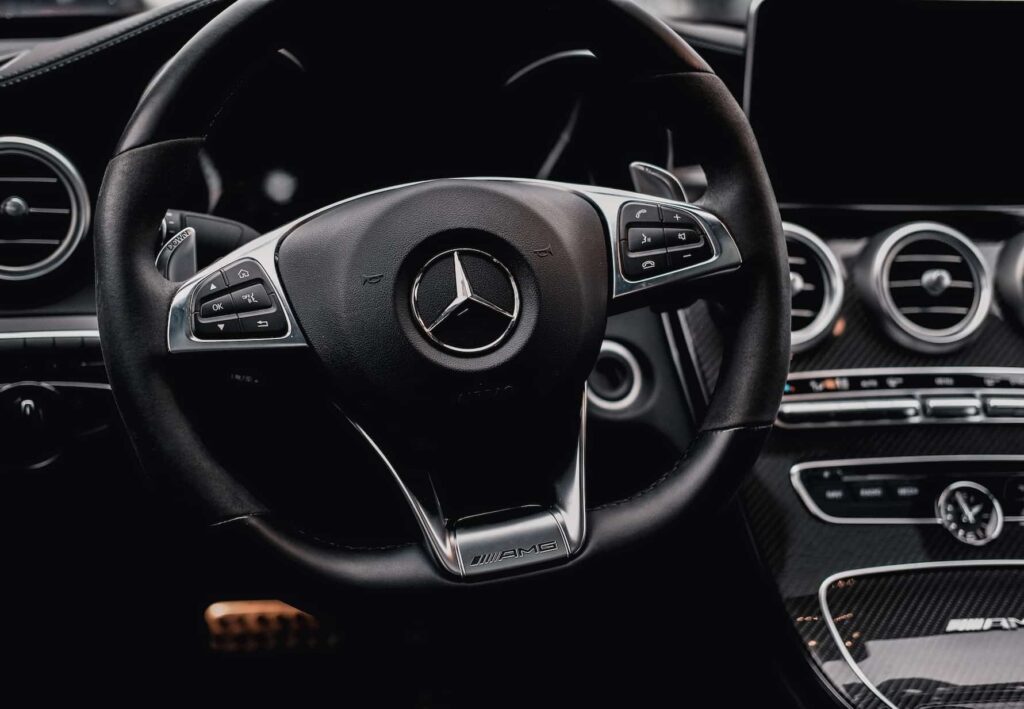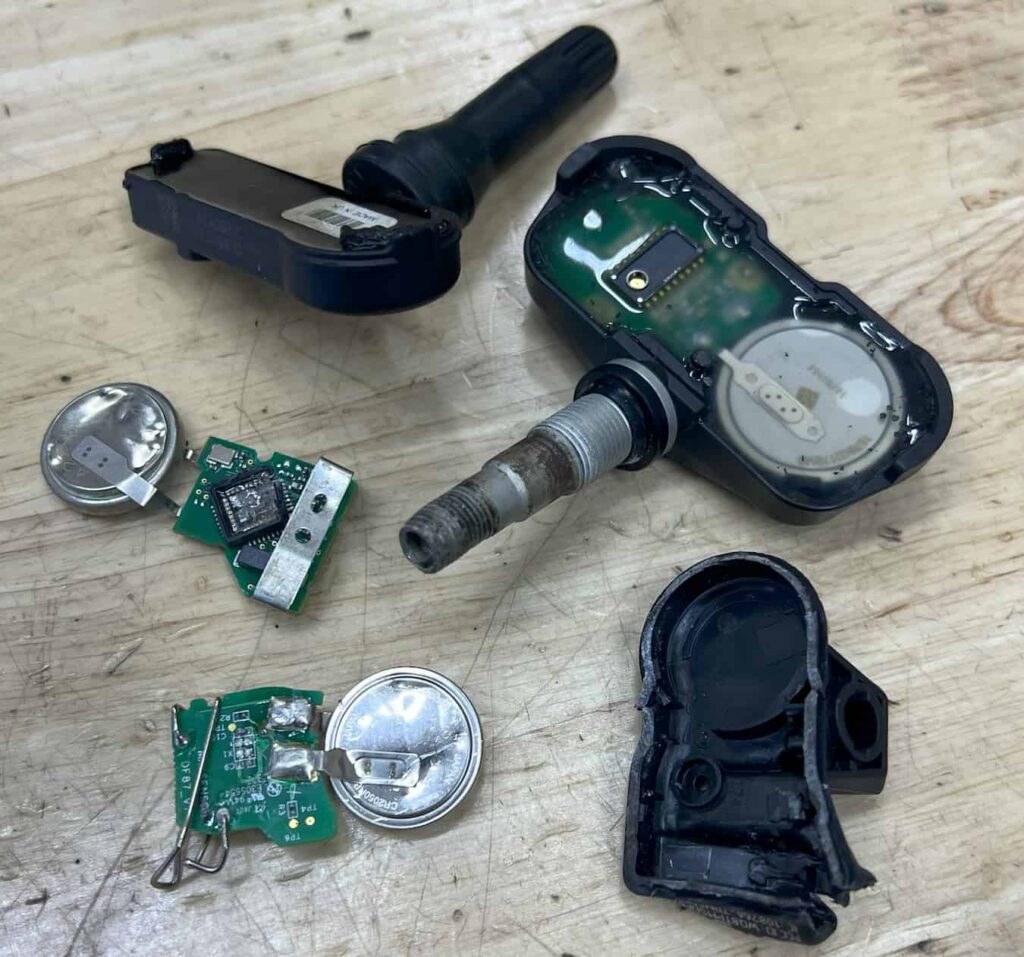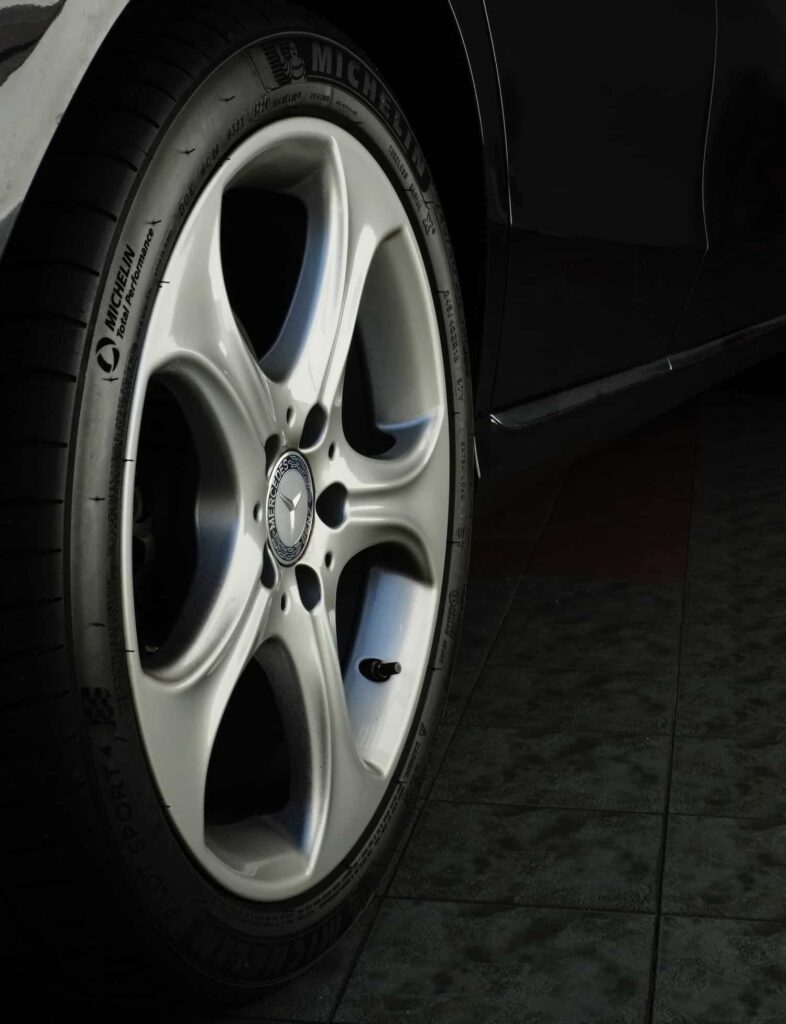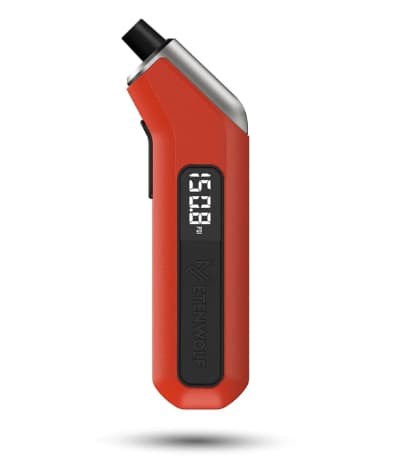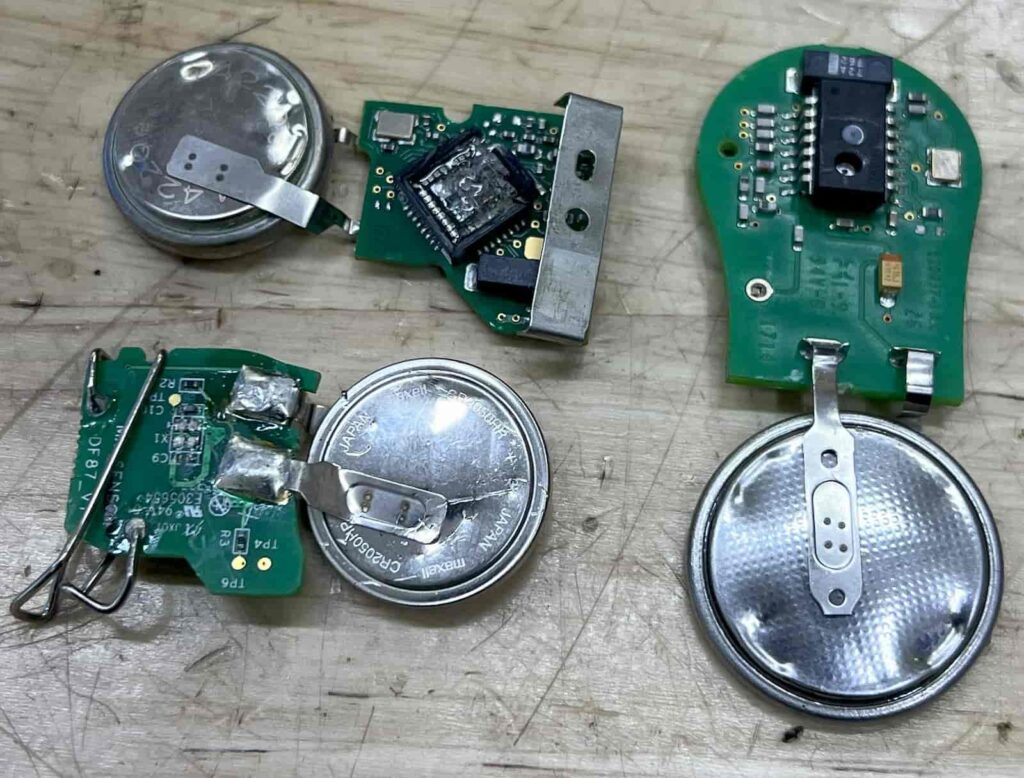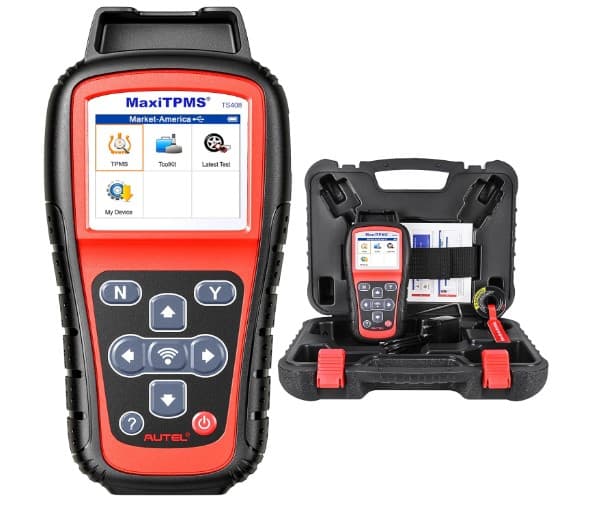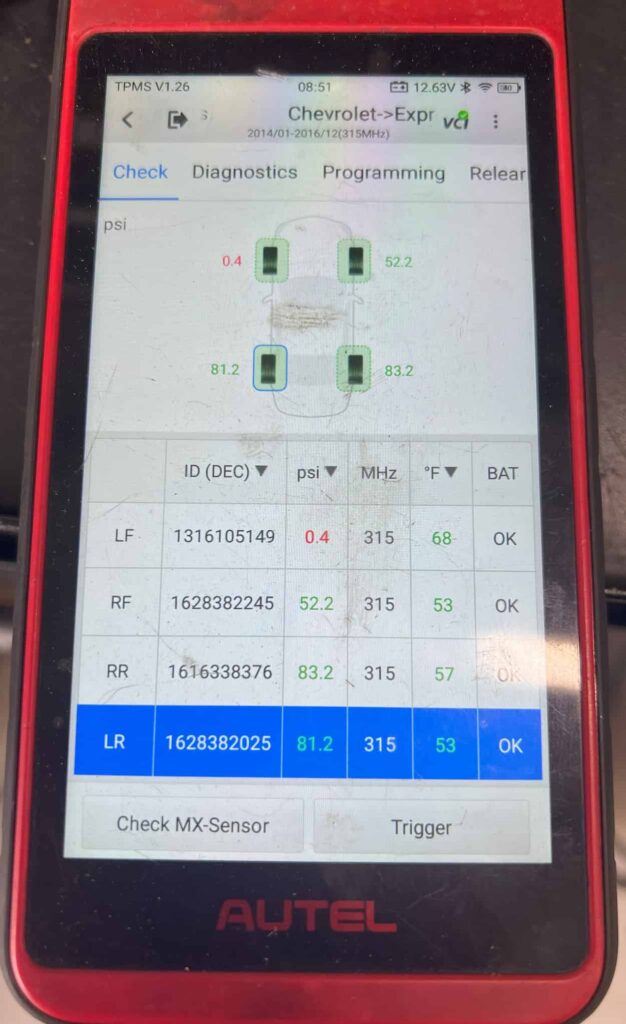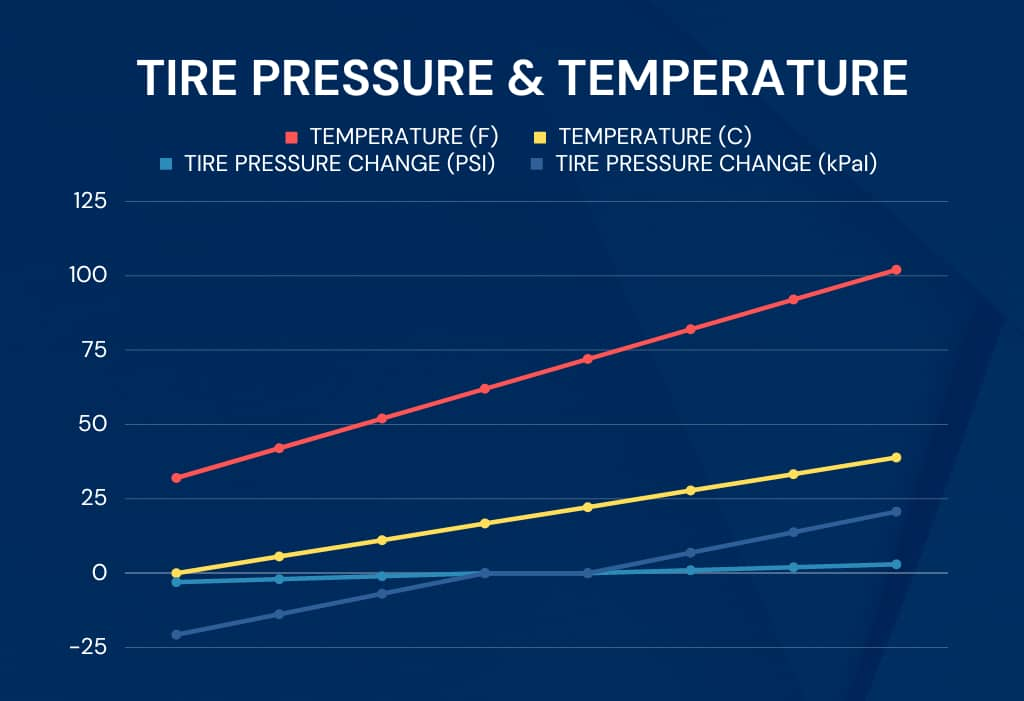How to Reset and Calibrate Mercedes Benz C-Class Tire Pressure System
Mercedes Benz C-Class (2020-2024)
Fill the tires to the recommended air pressures.
Press the START/ENGINE/STOP button twice, without your foot on the brake.
Press the BACK or ENTER button on the left side of the steering wheel to exit the prompt “Depress Brake to Start Engine”
Press the HOME button on the left side of the steering wheel.
Use the ENTER/SCROLL button to scroll all the way to the right to SERVICE.
Select SERVICE using the ENTER/SCROLL button.
Scroll down and select TIRES.
Use the scroll button and SCROLL down when prompted with “Tire pressure will be displayed after driving a few minutes”
Select OK when prompted “Use Current Pressures as New Reference Values”.
If successful a message will appear “Tire Press. Monitor Restarted”.
Mercedes Benz C-Class (2014-2020)
Set all four tires to the Mercedes C Class recommended cold air pressure values.
Start the engine or put the ignition into RUN mode.
Press the HOME button on the left side of the steering wheel.
Scroll down using the Arrow buttons on the steering wheel and select SERVICE by pressing the OK button.
Scroll down and select TIRE PRESSURE.
A message will appear “Tire pressure will be displayed after driving a few minutes”.
Press the DOWN ARROW button once.
A message will read “Use current pressures as new reference values”
Press the OK button.
Mercedes Benz C-Class (2007-2013)
Fill all 4 tires to the recommended cold tire pressures.
Start the engine or turn the key to the second position in the ignition, which puts the Mercedes C Class into RUN mode.
Use the RIGHT ARROW button on the left side of the steering wheel to scroll through the information display screen until you reach SERV.
Use the DOWN ARROW button on the steering wheel and select TIRE PRESSURE using the OK button.
A message will appear “Tire pressures will be displayed after driving a few minutes” Press the DOWN ARROW on the steering wheel.
Another message will appear “Use Current Pressures as New Reference Values”.
Press the OK button.
What is the Mercedes Benz C-Class TPMS?
The TPMS (Tire Pressure Monitoring System) in the Mercedes C Class is a sophisticated feature designed to monitor the air pressure within each of the four tires. This system employs a quartet of sensors, one located in each tire, and is supported by a dedicated TPMS receiver module. Additionally, it integrates with the vehicle’s main computer, commonly referred to as the ECU (Engine Control Unit) or ECM (Engine Control Module), to ensure optimal tire pressure in the Mercedes C Class
HOW DOES THE MERCEDES BENZ C-CLASS TPMS WORK?
Mercedes C Class Tire Pressure Monitoring Sensors: The tire pressure sensors in each Mercedes C Class tire consist of a compact chip, a battery, and a radio transmitter, all encased within a small plastic housing. This housing is connected to the valve stem. The chip, powered by the battery, is responsible for measuring the tire’s current air pressure, while the transmitter communicates this data to the vehicle’s TPMS receiver module using radio waves.
Mercedes C Class TPMS Receiver Module: The TPMS module is crucial in the system, as it collects air pressure readings from each tire’s sensor. Once gathered, this information is then relayed to the main computer of the Mercedes C Class.
Mercedes C Class ECU: The ECU (Engine Control Unit) of the Mercedes C-Class plays a pivotal role in analyzing tire pressure data. It compares the received readings with pre-set air pressure standards defined by Mercedes for the C Class. For instance, if a tire’s pressure falls to 30 Psi, significantly lower than the recommended 39 Psi, the ECU triggers a Low Tire Pressure warning to alert the driver via the vehicle’s information display.
2020-2024 MERCEDES C-CLASS RECOMMENDED TIRE PRESSURE
Mercedes C Class Tire Size | Front Psi/kPa | Rear Psi/kPa |
225/50R17 | 39/268 | 45/310 |
225/45R18 | 39/268 | |
245/40R18 | 45/310 | |
225/40R19 | 38/268 | |
255/35R19 | 45/310 |
WHAT SHOULD YOU DO WHEN YOUR LOW TIRE PRESSURE LIGHT TURNS ON?
When the low tire pressure indicator illuminates in your Mercedes C Class, it’s important to find a secure location to stop and examine the tire pressures. We recommend not solely relying on the tire pressure display in the Mercedes C-Class, instead use a digital tire pressure gauge. Also, carefully inspect each tire and wheel to ensure there are no obvious problems
Common Issues Causing Mercedes C-Class Tire Pressure Light to Trigger
Improper tire inflation levels (either overinflation or underinflation)
Utilization of the vehicle’s emergency spare tire. (Mercedes C-Class Spare tire or donut does NOT have a tire pressure sensor in it)
Degraded or malfunctioning batteries within the TPMS sensors
Complications with the TPMS receiver module or the vehicle’s main computer (ECM/ECU)
External electromagnetic interference from surrounding vehicles or electronics. (nearby radios, cell phones, alarm systems)
Changes of 10 degrees or more in air temperature
Exceeding the vehicle’s maximum load capacity or its specified towing limits
Application of tire chains
Excessively dark window tints on the car
Fluctuations in the temperature of the road surface
Fitting tires that are either incorrect in size or not in line with the Mercedes C Class’s original specifications
Harm to TPMS sensors incurred during tire replacement or maintenance
Failure to reset or recalibrate the Mercedes TPMS post-tire inflation or maintenance
Tires suffering from punctures or air leaks
Physical damage to the tires or wheels due to road debris or general wear
Valve stems on tires that are either not functioning properly or have been installed incorrectly.
Fgf
ADJUSTING TIRE PRESSURE IN A COLD STATE FOR MERCEDES C-CLASS
If you look closely at the tire pressure label on the Mercedes C-Class driver side door panel, it states the recommended COLD tire pressure for the front and rear tires. Tire pressure guidelines refer to the measurement of tires in a “cold” condition. Essentially, if the advised tire pressure for a Mercedes C Class rear tires is 45 PSI, you should set the pressure to 45 PSI while the tires are cold. Tires are considered cold either before the vehicle has been driven or after it has been stationary for at least 3 hours since last use. Altering the tire pressure when the tires are warm will likely result in overinflation.
THE CHANGE IN MERCEDES C-CLASS TIRE PRESSURE AFTER 20 MINUTES OF DRIVING
Should your Mercedes C Class tires be warm, possibly due to recent use or external heat conditions, the air pressure readings may falsely appear elevated. Adjusting the tire pressure under these circumstances often leads to excessive inflation, as the real air pressure is lower than what is displayed. For example, if you drive your Mercedes C-Class for 20 minutes, the air pressure in the tires can increase by about 2-5 Psi above the initial cold air pressure.
IMPACT OF ALTITUDE ON MERCEDES C-CLASS AIR PRESSURE
The tire pressure indicator in your Mercedes C-Class is unlikely to activate simply due to elevation gain during driving. As you ascend to higher altitudes, the internal air pressure of your tires tends to increase. For every 1,000 feet of elevation gained, the tire pressure typically rises by approximately 0.5 Psi. This means that if you drive down a mountain from 10,000 feet to sea level, your tire pressure will decrease by about 5 Psi.
Lifespan of Mercedes C-Class Tire Pressure Sensor Batteries
Each tire pressure sensor in the Mercedes C Class is equipped with its own non-replaceable, non-rechargeable silver oxide battery. These batteries can endure for a duration ranging from 5 to 15 years, or roughly 150,000 miles. Once the battery of a Mercedes C-Class tire pressure sensor is depleted, the entire sensor must be substituted with a new unit. Use a TPMS diagnostic tool to determine the exact battery levels of your Mercedes C-Class tire pressure sensors.
SAFETY CONSIDERATIONS FOR DRIVING WITH LOW TIRE PRESSURE IN MERCEDES BENZ C-CLASS
Operating your Mercedes C Class with underinflated tires poses a safety risk. In case of a tire losing air, it’s important to get it fixed or replaced promptly. However, if the low tire pressure warning is due to a depleted tire pressure sensor battery, driving remains safe provided that the tires maintain the appropriate air pressure
WHAT IS THE DRIVING DISTANCE LIMIT ONCE THE LOW TIRE PRESSURE LIGHT ACTIVATES?
Upon the activation of the low tire pressure indicator in a Mercedes C Class, there isn’t a specific distance or time limit deemed safe for continued driving. It’s crucial to halt your journey at the earliest convenience, conduct a visual inspection of all tires, and use a digital air pressure gauge to check each tire’s pressure. Relying exclusively on the air pressure readings displayed by the Mercedes C-Class’s information system is not advisable.
CHANGING THE WHEELS OR TIRES ON THE MERCEDES C-CLASS
When changing the wheels or rims of your Mercedes C-Class, you have a couple of choices:
Transfer the original Mercedes-Benz tire pressure sensors from the existing wheels to the new ones.
Acquire programmable tire pressure sensors, fit them onto the new wheels, and synchronize them with the Mercedes C-Class ECU. You will need a TPMS programming tool for this option.
For tire replacements on the Mercedes C-Class, adhere to the usual procedure for resetting the Mercedes C Class tire pressure light.
WHY IS THE MERCEDES BENZ TIRE LIGHT FLASHING?
If the tire pressure light on your Mercedes C-Class is blinking, it indicates a communication issue between one or more tire pressure sensors and the car’s ECU. This problem can arise due to three main reasons:
The vehicle’s spare tire has been installed.
The battery of a tire pressure sensor is either depleted or running low.
A tire pressure sensor has sustained damage or is malfunctioning, leading to a loss of communication with the Mercedes TPMS module.
IS IT POSSIBLE TO DEACTIVATE THE TPMS IN MERCEDES CARS?
The tire pressure monitoring system in the Mercedes C-Class is designed to be permanently active and cannot be turned off. If the tire pressure sensors are removed and substituted with valve stems without sensors, the tire pressure light will initially flash and then stay lit continuously. This situation is recognized as a TPMS (Tire Pressure Monitoring System) malfunction.
TPMS DIAGNOSTIC TOOLS FOR EVALUATING MERCEDES BENZ TPMS SENSORS
Tire pressure diagnostic devices excel in assessing and troubleshooting problematic Mercedes C-Class tire pressure sensors. These tools can perform a thorough scan of each sensor and generate a detailed analysis report. This report includes information on the sensor’s battery life, signal strength, the tire’s temperature, the sensor’s MHz frequency, and the specific location of each sensor on the vehicle. Any Mercedes C-Class TPMS Sensors displaying problems such as a low battery or weak signal need to be substituted with new ones and then programmed to the Mercedes TPMS module and ECU.
CAN WEATHER CHANGES TRIGGER THE MERCEDES BENZ TIRE PRESSURE ALERT SYSTEM?
A frequent reason for the activation of the low tire alert in the Mercedes C-Class is weather-related changes. Tire pressure tends to vary by approximately 1 Psi for every 10°F shift in the ambient temperature. For instance, a temperature drop of 43°F over a month could lower the tire pressure in your Mercedes C-Class from 39 Psi to 34 Psi, triggering the low tire pressure light. Since fluctuations in air temperature are a given, particularly in certain regions, it’s advised to check your Mercedes C-Class tire pressure at least once every few weeks, and only do so when the tires are cold to prevent any overinflation problems.
WHY IS THE MERCEDES TIRE LIGHT ON DESPITE THE TIRES APPEARING IN GOOD CONDITION?
Do not judge the condition of tires merely by their appearance. It’s essential to always check the air pressure of your Mercedes C-Class tires manually with a digital tire pressure gauge, especially if you suspect a problem. If the low tire pressure indicator shuts off after inflating the tires, this confirms that the TPMS is functioning properly.
DETECTING TIRE LEAKS USING SOAPY WATER
To precisely locate a leak in a tire, follow these steps:
Inflate the problematic tire to at least 40 Psi.
Prepare a mixture of water and liquid soap in a spray bottle.
Thoroughly spray the soapy solution across the tire, with special focus on the bead and valve stem areas.
Look for any bubbles forming and trace them back to their origin to pinpoint the leak’s location.
RESETTING MERCEDES C-CLASS TPMS BY DISCONNECTING THE 12-VOLT BATTERY
If the low tire pressure warning on your Mercedes C-Class doesn’t shut off even after resetting and calibrating the tire pressure system, you might consider disconnecting the vehicle’s main 12-volt battery to reset any temporary TPMS codes in the car’s ECU. Here are the steps to follow:
Ensure the engine and all electronic devices (such as the radio and lights) are switched off.
Loosen and remove the negative terminal clamp from the battery.
Wait for a short period before reattaching the terminal and securing it tightly.
This procedure should turn off the low tire pressure light. However, if the Mercedes C-Class low tire alert reactivates while driving, it may indicate an issue with a tire pressure sensor or a tire that is steadily losing air.
IMPORTANCE OF PROPER TIRE PRESSURE FOR FUEL EFFICIENCY
Keeping your Mercedes C-Class tires at the recommended air pressure is key to optimizing fuel economy. When tires are underinflated they create more rolling resistance, forcing the engine to exert more effort and consume more fuel. A decrease of just 1 Psi in all tires can lead to a 0.2% reduction in fuel efficiency. Therefore, an underinflation of 5 Psi, which is quite common, may result in a 1% drop in miles per gallon (MPG). For a vehicle like the Mercedes C-Class, which typically gets 25-35 MPG, this 1% reduction translates to increased fuel usage – roughly an additional gallon burned for every 2,500 miles driven.
TIRE PLUGS
With a decade of experience as an automotive technician, I frequently utilize tire plugs for fixing tire punctures and find them to be safe and efficient when applied properly. It’s important to avoid using tire plugs on tires with significantly worn treads or on the tire sidewall. For larger punctures or leaks, opting for a tire patch or a complete tire replacement is advisable.
TIRE SEALANTS
Indeed, tire sealants have the potential to harm tire pressure sensors. Should you employ a tire sealant for a temporary fix, it’s recommended to have your local repair shop clean the tire and conduct a check on the tire pressure sensors to ensure they remain functional.
Everything in this article is applicable to all Mercedes C Class models and versions built between 2007-2024 including the Mercedes C 180, C200 C 240, Mercedes Benz C300, Mercedes Benz C350, Mercedes Benz C63 Amg, C220d, and more.
Please note that this blog post contains Amazon affiliate links. This means that if you make a purchase through one of these links, we at TPMSRESET.COM may earn a small commission at no extra cost to you. We only recommend products that we personally use and believe in. Thank you for supporting us.
